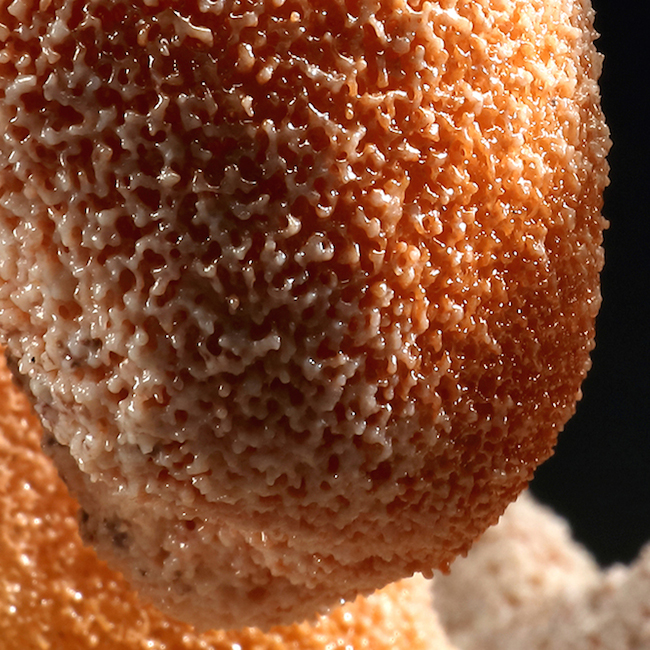Irish artist and designer Zsiri Melinda Dempsey said her exhibition at Yingge Ceramics Museum, Taiwan, Conscious Unconsciousness (December 7 – 23, 2015), encourages the viewer to reflect on double standards rampant in modern society, especially in regards to unsustainable systems of production, consumption, and disposal.

Zsiri Dempsey, Conscious Unconsciousness I, 2015, stoneware and wood fired porcelain, 45 x 24 x 19 cm
She does this via experimental sculptures made by firing porcelain soaked sponges. These sponges are pleasing to the eye while they’re being fired, but they also emit toxic fumes as they burn. In those forms Dempsey saw a metaphor for how the ends justify the means for many people. People can choose to remain deliberately ignorant and downplay their actions, but there are consequences. Dempsey uses the series to emphasize those consequences.

Conscious Unconsciousness I (detail).
‘’As with most of my projects this one began with material research. I conducted this research by experimenting with soft absorbent materials and porcelain slip. After some successful small scale tests using sponge and porcelain slip I decided to further develop this area of experimentation as well as to increase scale. With this increase in scale I achieved the desired finish, I did however have to face the fact that this working method releases harmful toxic fumes.
“At this point I began to research plastic pollution. Based on this research, coupled with discussions I had with scientists, I have been reassured that the amount of pollution I produce when creating my art is relatively insignificant and less than a drop in the sea. My mind was put at ease for a short time, however a confrontation soon engulfed me due to my personal environmentally friendly and health conscious life style. The sense of guilt caused by this contradiction soon began to overtake the project itself, leading me to realize that this duality which I was experiencing was the essence of the project.’’

Zsiri Dempsey, Conscious Unconsciousness I & IV (detail), 2015, wood fired porcelain and unfired porcelain. Click to see a larger image.

Zsiri Dempsey, Conscious Unconsciousness VI, 2015, unfired porcelain, 35 x 18 x 20 cm. Click to see a larger image.
Conscious Unconsciousness includes both fired and unfired pieces. The fired pieces bear a striking resemblance to sea organisms such as coral reefs. These are synonymous with sustaining life and have the potential to do so for thousands of years. Yet, tragically due to the actions of humankind these hotspots of marine life are now in decline. This tragic undertone is highlighted by the unfired pieces, which the artists creates by using a blow torch to burn away the sponge part of the sculptures, resulting in a disturbing, scorched black finish which confronts the viewer with a grim allegory of destructive consequences which we often try to disassociate from our actions.

Zsiri Dempsey, Conscious Unconsciousness VII, 2015, wood fired porcelain and stoneware, 45 x 24 x 19 cm
Dempsey said she thinks of ceramics as an open-ended medium, arguing that it’s not easy to categorize a person who works with clay. She imagines a spectrum with “pure design” and “pure art” at opposite ends.
“I would say that in my work I wear two skins, that of a fine artist and of a designer. They are both parts of my practice but obviously one of them will temporarily overpower the other. I can achieve different aspects of my creative goals while working within the design industry than when preparing pieces to be in a fine art gallery. This approach allows me to have two completely different ways of thinking, while still handling the same materials.”
You can see both Dempsey’s fine art and her fine design on her website.
What do you think of Dempsey’s haunting experiments in contemporary ceramics? Let us know in the comments.
Text (edited) and photographs courtesy of the artist.

Zsiri Dempsey, Conscious Unconsciousness XIII, 2015, wood fired porcelain and stoneware, 60 x 23 x 19 cm. Click to see a larger image.

Zsiri Dempsey, Conscious Unconsciousness III & IV, 2015, unfired porcelain and gas fired porcelain, both 60 x 18 x 20 cm

Zsiri Dempsey, Conscious Unconsciousness III, 2015, gas fired porcelain and stoneware, 60 x 18 x 20 cm. Click to see a larger image.

Zsiri Dempsey, Conscious Unconsciousness (exhibition view). Photographs courtesy of the artist and the museum.

Everything we do has consequences, some intended but mostly unintended.
Her ceramic pieces are beautiful and intriguing. I don’t care for breast-beating in art. Make it or don’t make, but don’t preach, please.
Absolutely brilliant!
Doesn’t all firings release toxic fumes? How is this different other using a sponge? I love the art just curious about the accuracy of the title. I have had this idea myself.
Hey Nicholas!
Yes all firing release toxic fumes but not in the same level. Many sponges are made from polyester which is highly toxic and we have a hard time dealing with the sponge waste. Lately the sponge industry come up with alternative more environment friendly options.
With this in mind I needed time to find a sponge that suits for my artistic ambitions and our environment. Recently I began using non-toxic cellulose sponge as a response to this matter.